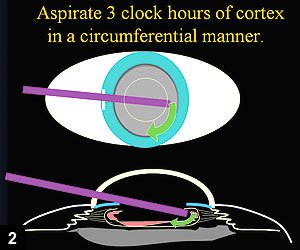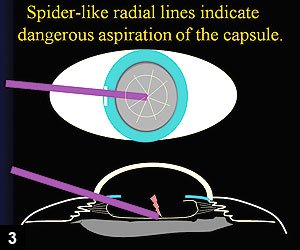Thorough cortical cleanup needed for successful cataract surgery
A technique for removing the remaining lens cortical material after phacoemulsification is explained.

After removing the cataract nucleus via phacoemulsification, the remaining lens cortical material needs to be gently removed from the capsular bag. A thorough cortical cleanup helps to ensure a clear capsule and visual axis, a quiet eye with a low level of inflammation and prevention of posterior capsular opacification.
Once the nucleus is removed, the remaining lens cortical material must be thoroughly cleaned from the capsular bag. It is not acceptable to leave a significant amount of lens cortex in the eye at the end of the cataract surgery because it will induce inflammation and may affect the patient’s vision and comfort level. Cortex removal requires a delicate touch because we are working in direct proximity to the fragile capsular bag.
 Uday Devgan |
The amount of cortex adherent to the capsular bag is proportional to the effectiveness of the hydrodissection performed before nucleus removal. Techniques such as I. Howard Fine, MD’s cortical cleaving hydrodissection are helpful. As much of the nucleus and epi-nucleus as possible should be removed with the phaco probe before switching to the irrigation and aspiration handpiece. The I&A handpiece has a much smaller opening as compared with the phaco needle, which allows for more control and a higher vacuum level while maintaining the stability of the anterior chamber.
Any small, stray nuclear fragments can be removed by using the I&A tip with a second instrument, either a chopper or a spatula, via the paracentesis. When the small nuclear chips become stuck at the I&A tip opening, simply use the second instrument to push them into the port. The action is similar to using a fork to mash potatoes and is a mechanical means to force the nuclear chips into the small I&A suction port.
Cortex removal technique
For cortex removal, the I&A probe is placed under the edge of the capsulorrhexis, and the cortex is grabbed from within the capsule, near the lens equator (Figure 1). The key for efficient cortex removal is to move in a circumferential manner. You should aim to grab at least a few clock hours of cortex by moving circumferentially before bringing the probe radial toward the center of the eye. The goal is to remove a few large sheets of cortex material instead of pulling many small strips of cortex. Removing a large sheet of cortex allows for safer and more efficient cortical cleanup and is less likely to result in residual cortical material in the capsular bag.
 The I&A probe is placed under the edge of the capsulorrhexis, and the cortex is grabbed from within the capsule, near the lens equator. | |
 Remove about 3 clock hours of cortex at a time with the circumferential technique. | |
 If spider-like wrinkles appear on the posterior capsule, the cause is most likely aspiration of the capsule, and you should immediately release the vacuum by going to foot position 1, and if that does not resolve the issue, go to reflux position. Images: Devgan U |
My preferred technique is to remove about 3 clock hours of cortex at a time with the circumferential technique (Figure 2). When it comes to the subincisional cortex, the I&A tip can be positioned so that it is facing inferiorly, toward the underlying capsular bag. Once the cortical piece is held via the suction of the I&A tip, move the probe toward the center of the eye and bring the port upward to complete the aspiration.
If the posterior capsule is inadvertently suctioned during the removal of the lens cortex, care should be taken to stop and release it. The foot pedal has a position called “reflux” in which the vacuum is stopped and the fluid pump is reversed to release any trapped material. This reflux position is typically used to reverse the aspiration of fluid and to release the tissue, such as posterior capsule or iris, that was inadvertently grabbed. If spider-like wrinkles (Figure 3) appear on the posterior capsule, the cause is most likely aspiration of the capsule, and you should immediately release the vacuum by going to foot position 1, and if that does not resolve the issue, go to reflux position.
When some little residual cortex fragments are left on the posterior capsule, a more gentle setting can be programmed into the phaco machine. With a setting such as “capsule polish” or “capsule vacuum,” we can use low flow and low vacuum to remove these last few bits of cortex while being careful not to damage the posterior capsule.
In small-pupil cases, remember that the cortex needs to be removed from the equator region of the capsular bag, which may be out of view, blocked by the iris tissue. Care should be taken to remove as much cortex as possible so that postop inflammation and PCO are minimized. Use of the new silicone-coated soft I&A tips allows a higher margin of safety because no metal will come in contact with the posterior capsule.
Our goal at the end of cortex removal is to have a clean and clear capsular bag, ready to accept our IOL. Doing a thorough cortical cleanup is instrumental in the success of your surgery.
For more information:
- Uday Devgan, MD, FACS, is in private practice at Devgan Eye Surgery in Los Angeles, Beverly Hills, and Newport Beach, California. Dr. Devgan is Chief of Ophthalmology at Olive View UCLA Medical Center and an Associate Clinical Professor at the Jules Stein Eye Institute at the UCLA School of Medicine. Dr. Devgan can be reached at 11600 Wilshire Blvd., Suite 200, Los Angeles, CA 90025; 800-337-1969; fax: 310-388-3028; e-mail: devgan@gmail.com; Web site: www.DevganEye.com. Dr.Devgan is a consultant to Abbott Medical Optics and Bausch & Lomb, and is a stockholder in Alcon Laboratories and formerly in Advanced Medical Optics.
